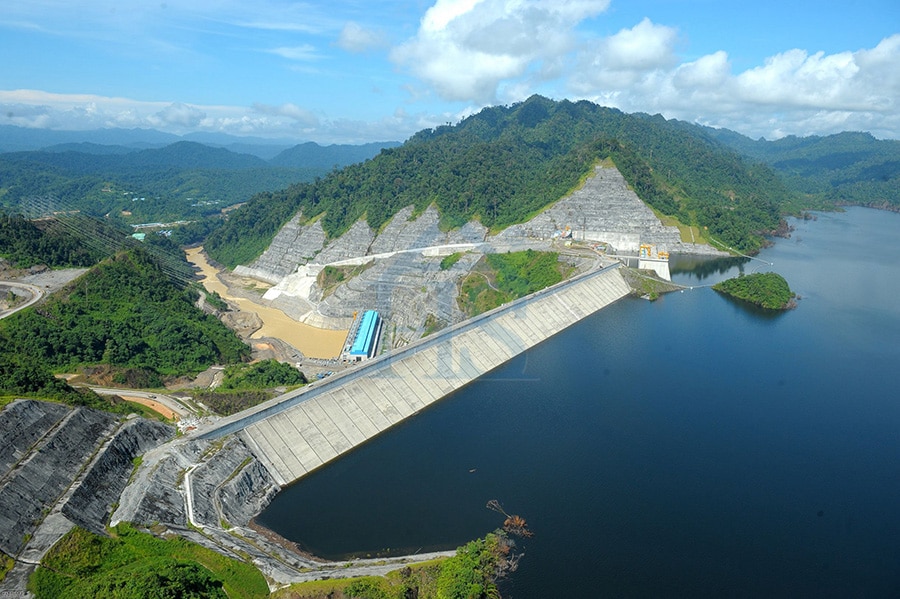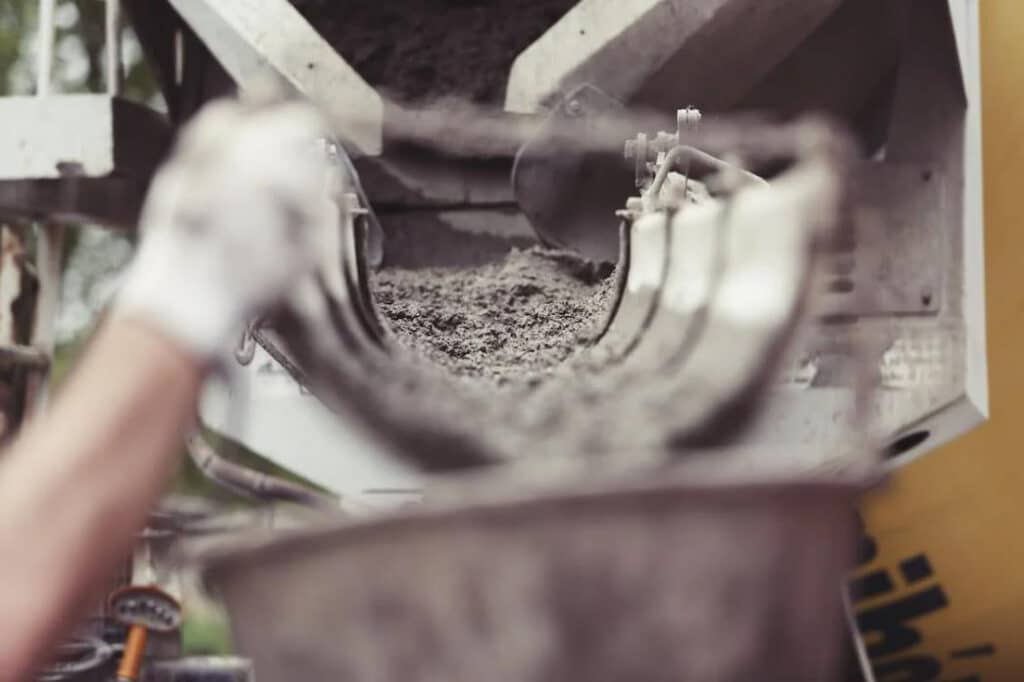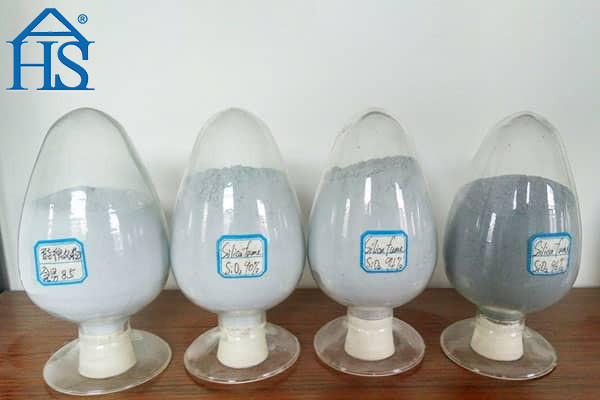RCC ist ein Nulleinbruch, Betonmischung mit geringem Wassergehalt, die mit Vibrationswalzen verdichtet wird. Es wird häufig in Gehwegen verwendet, Dämme, und strapazierfähige Industrieböden aufgrund seiner hohen Festigkeit und Langlebigkeit.
Wie Silica Fume RCC verbessert
Wenn Quarzstaub zu RCC hinzugefügt wird, es reagiert mit dem bei der Zementhydratation entstehenden Calciumhydroxid, Bildung von Calciumsilikathydrat (CSH). Das resultierende CSH ist dichter und stärker, was die Gesamteigenschaften des Betons verbessert. Außerdem, Die ultrafeinen Silikastaubpartikel füllen die Hohlräume zwischen den Zementpartikeln, Schaffung einer dichteren und undurchlässigeren Betonmatrix.
Vorteile von Silica Fume bei RCC
Die Einarbeitung von Silikastaub in RCC bietet zahlreiche Vorteile, einschließlich:
Verbesserte Stärke
Silikastaub erhöht sowohl die Druck- als auch die Zugfestigkeit von RCC, wodurch es besser für Hochleistungsanwendungen geeignet ist.
Erhöhte Haltbarkeit
Das dichtere CSH, das durch die Reaktion zwischen Silikastaub und Calciumhydroxid entsteht, erhöht die Haltbarkeit von RCC, Es schützt es vor chemischen Angriffen und reduziert seinen langfristigen Wartungsaufwand.
Reduzierte Durchlässigkeit
Die ultrafeinen Partikel des Silikatrauchs füllen die Hohlräume in der Betonmatrix, Verringerung der Durchlässigkeit und Verbesserung der Beständigkeit des Betons gegen das Eindringen von Wasser und Chloridionen.
Erhöhte Abriebfestigkeit
Der Zusatz von Quarzstaub zu RCC verbessert dessen Abriebfestigkeit, wodurch es widerstandsfähiger gegen Verschleiß wird, insbesondere in industriellen Umgebungen.
Bessere Frost-Tau-Beständigkeit
Der Beitrag von Silica-Rauch zu einer dichteren Betonmatrix führt zu einer erhöhten Frost-Tausalz-Beständigkeit, Dadurch eignet sich RCC besser für den Einsatz in kalten Klimazonen.
Die Rolle von Silica-Rauch bei der Reduzierung des Zementgehalts
Einer der Hauptvorteile der Verwendung von Quarzstaub in RCC besteht darin, dass er eine Reduzierung des Zementgehalts ermöglicht, ohne die Leistung des Betons zu beeinträchtigen. Durch teilweises Ersetzen von Zement durch Silicastaub, Die Gesamtkosten der Betonmischung können gesenkt werden, und die Umweltauswirkungen der Zementproduktion können minimiert werden.
Fallstudien: Erfolgreiche Anwendungen von Silica-Rauch in RCC

1. Speckdamm, Malaysia
Fertiggestellt in 2011, Der Bakun-Staudamm ist der höchste Betondamm in Südostasien. Der RCC-Mischung wurde Silikatrauch beigemischt, um die Festigkeit des Damms zu verbessern, Haltbarkeit, und Beständigkeit gegen chemische Angriffe. Als Ergebnis, Der Damm hat eine außergewöhnliche Leistung gezeigt, indem er der rauen tropischen Umgebung und dem immensen Druck des gestauten Wassers standgehalten hat.
2. Gibe III-Staudamm, Äthiopien
Der Gibe-III-Staudamm, abgeschlossen in 2016, ist der drittgrößte RCC-Staudamm in Afrika. Silikatrauch spielte eine entscheidende Rolle bei der Verbesserung der Festigkeit und Haltbarkeit des Betons, Dadurch ist es für die aggressive Umgebung geeignet, Dazu gehörte auch die Exposition gegenüber schwankenden Wasserständen und variablen Temperaturen. Der Damm erzeugt jetzt 1,870 MW Leistung, trägt erheblich zur Stromversorgung Äthiopiens bei.
3. Oberer Stillwater-Staudamm, Vereinigte Staaten
Befindet sich in Utah, Der Upper Stillwater Dam wurde im Jahr fertiggestellt 1987 und war der erste große RCC-Staudamm in den Vereinigten Staaten. Die Verwendung von Quarzstaub in der RCC-Mischung führte zu einer erhöhten Druckfestigkeit, reduzierte Durchlässigkeit, und verbesserte Haltbarkeit. Durch diese Verbesserungen konnte der Damm den Belastungen standhalten, die mit seiner Hauptfunktion als Hochwasserschutz- und Wasserspeicheranlage einhergehen.
Diese erfolgreichen Anwendungen von Quarzstaub in walzenverdichtetem Beton zeigen die Vielseitigkeit und das Potenzial des Materials zur Verbesserung der Leistung verschiedener Arten von Projekten auf der ganzen Welt.
Abschluss
Die Einarbeitung von Quarzstaub in walzenverdichteten Beton bietet zahlreiche Vorteile hinsichtlich der Festigkeit, Haltbarkeit, Permeabilität, Abriebfestigkeit, und Frost-Tausalz-Beständigkeit. Außerdem, die Umweltvorteile der Verwendung von Silikatrauch, einschließlich reduziertem Zementgehalt und Wiederverwendung von Industrieabfällen, machen es zu einer nachhaltigen Option für moderne Bauprojekte. Jedoch, Es müssen ordnungsgemäße Handhabungs- und Sicherheitsmaßnahmen beachtet werden, um die Herausforderungen und Einschränkungen zu überwinden, die mit der Verwendung von Quarzstaub in RCC verbunden sind.
Häufig gestellte Fragen
- Was ist die typische Dosierung von Silicastaub in RCC??
Die Dosierung von Silicastaub in RCC variiert je nach Projektanforderungen. Jedoch, es reicht typischerweise von 5% zu 15% nach Gewicht Zement.
- Kann Silica-Rauch zusammen mit anderen verwendet werden? ergänzende zementartige Materialien?
Ja, Quarzstaub kann in Kombination mit anderen ergänzenden zementären Materialien verwendet werden, wie Flugasche und Schlacke, um die Eigenschaften von RCC weiter zu verbessern.
- Beeinflusst die Zugabe von Silicastaub den Aushärtungsprozess von RCC??
Die Zugabe von Silicastaub kann aufgrund seiner hohen Reaktivität Anpassungen des Aushärtungsprozesses erforderlich machen. Eine ausreichende Aushärtung ist wichtig, um die gewünschte Leistung von RCC mit Silicastaub sicherzustellen.
- Ist Quarzstaub für alle Arten von Betonprojekten geeignet??
Während Silica-Dampf zahlreiche Vorteile bietet, Seine Eignung hängt von den spezifischen Projektanforderungen und den gewünschten Eigenschaften des Betons ab. Es ist wichtig, Ingenieure und Materiallieferanten zu konsultieren, um die geeignete Verwendung von Quarzstaub in einem bestimmten Projekt zu bestimmen.
- How is silica fume added to the RCC mix?
Silica fume can be added to the RCC mix either as a dry powder or as a slurry, abhängig von den Anforderungen des Projekts und dem konkreten Produktionsprozess.





